The terrible economy has sent more people than ever out into the yard with shovels and seed packets. Harvest time is fast approaching, and gardeners of every experience level will soon be pondering that universal question, “What the heck am I supposed to do with all of this stuff? Who needs this much eggplant?”
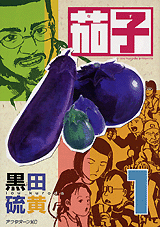 Leave it to Iou Kuroda to turn the ubiquitous, easy-to-grow fruit/vegetable into a manga series, Nasu, that I really, really wish someone would license and translate into English. It was originally serialized in Kodansha’s Afternoon magazine and collected in three volumes. Here’s what Wikipedia has to say about it:
Leave it to Iou Kuroda to turn the ubiquitous, easy-to-grow fruit/vegetable into a manga series, Nasu, that I really, really wish someone would license and translate into English. It was originally serialized in Kodansha’s Afternoon magazine and collected in three volumes. Here’s what Wikipedia has to say about it:
“Nasu is a collection of stories, focusing on a returning [DW — does the author maybe mean ‘recurring’?] series of characters, such as Takama, a farmer, and a young girl named Aya Takahashi, who begins the series abandoned by her father and residing in Tokyo with her two younger siblings, and as the manga progresses to its second volume, leaves the city to reside in the countryside with her relatives, near Takama’s farm. Apart from the chapters concerning Takama and Aya, other stories are also featured, such as one telling the chronicles of samurai in the Edo period hunting forbidden eggplant (nasu), another set atop a futuristic Mount Fuji, another tale concerning a truck driver, and also ‘Summer in Andalusia’, the story concerning the professional Spanish bicyclist Pepe Benengeli, from which the film was adapted.”
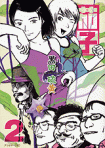 It was also published in French by Sakka, but I can’t find it anywhere on Sakka’s web site. Here are the listings for its three volumes on Amazon France.
It was also published in French by Sakka, but I can’t find it anywhere on Sakka’s web site. Here are the listings for its three volumes on Amazon France.
Aside from the fact that it sounds awesome, Kuroda is one of those creators who tops my “Please license more work from this person” wish list. This is based on my abiding love for his one work available in English, the splendid Sexy Voice and Robo (Viz), which was originally serialized in current buzz-anthology IKKI. Here’s some critical reaction to that book:

“So multi-layered is this manga that any attempts to explain the story end in ‘Oh, just read it and you’ll see.’ And there’s no reason not to read it—it’s smart enough for picky intellectual comics nerds, thrilling enough for action lovers, and deep enough for those who care about characters, emotions and drama.” Carlo Santos, Anime News Network
“Sexy Voice and Robo is a marvelous comic. Kuroda’s singular vision and craft transcend conventional ideas of genre and storytelling. It’s one of the best graphic novels I’ve read all year, and you really should try it, even if you don’t think you like manga.” Me, Comic World News
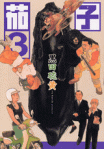 And here’s Shaenon K. Garrity’s image-rich celebration of the book in her Overlooked Manga Festival which, incidentally, is where I first heard about Nasu.
And here’s Shaenon K. Garrity’s image-rich celebration of the book in her Overlooked Manga Festival which, incidentally, is where I first heard about Nasu.
Seriously, I’ve never run into anyone (mostly the web version of “run into,” obviously) who has read Sexy Voice and Robo who doesn’t yearn for more of Kuroda’s work to be licensed and translated. And Viz, since you’re sharing IKKI titles online, why not throw Sexy Voice and Robo into the mix? It’s one of the best things you’ve ever, ever published, so give it a second chance.



 Posted by davidpwelsh
Posted by davidpwelsh  Tokumaru is a clumsy jock type. His sister reaches the breaking point with the breakage and insists he join their school’s tea ceremony club to “learn composure and grace if it kills [him]!” The club is run by stoic, dignified Hasune, who may have taken composure a little too far. Nobody who’s read a single chapter of a single yaoi title will be shocked to hear that these very different young men find themselves falling for each other, but Sakuragi does a nice job selling the notion that Tokumaru and Hasune are surprised, and pleasantly so.
Tokumaru is a clumsy jock type. His sister reaches the breaking point with the breakage and insists he join their school’s tea ceremony club to “learn composure and grace if it kills [him]!” The club is run by stoic, dignified Hasune, who may have taken composure a little too far. Nobody who’s read a single chapter of a single yaoi title will be shocked to hear that these very different young men find themselves falling for each other, but Sakuragi does a nice job selling the notion that Tokumaru and Hasune are surprised, and pleasantly so.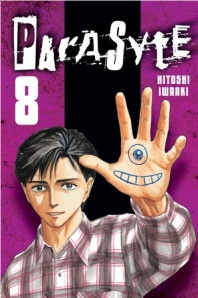 It’s the final volume of Hitoshi Iwaaki’s horror demi-classic
It’s the final volume of Hitoshi Iwaaki’s horror demi-classic 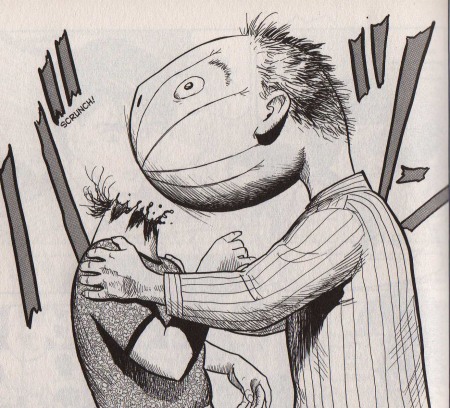
 You remember that girl who crawled out of the well in
You remember that girl who crawled out of the well in 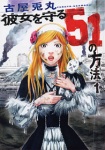 Of greatest interest to me is Usumaru Furuya’s
Of greatest interest to me is Usumaru Furuya’s  On the Viz front, there are two new Shonen Jump titles, one by the creative team behind Death Note. Tsugumi Ohba and Takeshi Obata reunited for Bakuman, about two students who dream of becoming successful manga-ka.
On the Viz front, there are two new Shonen Jump titles, one by the creative team behind Death Note. Tsugumi Ohba and Takeshi Obata reunited for Bakuman, about two students who dream of becoming successful manga-ka. 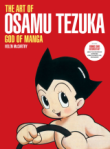 I’m not sure if this was announced first at the convention or if I just missed it when mentioned elsewhere, but I’m also looking forward to getting my hands on a copy of Helen McCarthy’s
I’m not sure if this was announced first at the convention or if I just missed it when mentioned elsewhere, but I’m also looking forward to getting my hands on a copy of Helen McCarthy’s 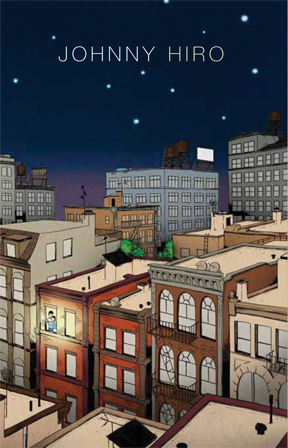 Johnny and Mayumi are young, in love, and living in New York City. That means they work too hard, live in a kind of crappy apartment, and never seem to have enough money at the end of the month. But they have each other and all of the affection, support and loyalty one could hope for; they also have cats. Those things go a long way to compensate for the overworked, underpaid grind.
Johnny and Mayumi are young, in love, and living in New York City. That means they work too hard, live in a kind of crappy apartment, and never seem to have enough money at the end of the month. But they have each other and all of the affection, support and loyalty one could hope for; they also have cats. Those things go a long way to compensate for the overworked, underpaid grind.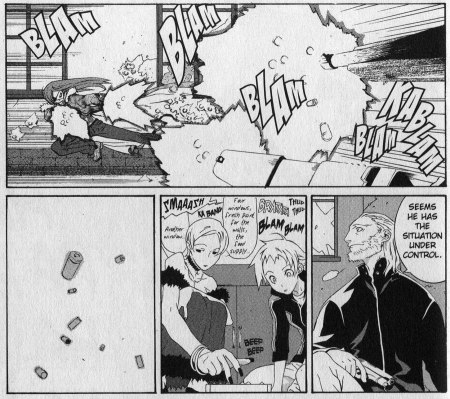
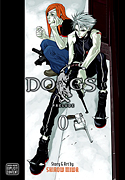 That isn’t to suggest that Miwa’s milieu is a pleasant one. The book’s linked short stories are set in a futuristic dystopia full of sometimes terrible people doing what they need to do to get by. Like all good noir casts, the characters all have dark and painful secrets to tote around as they navigate these murky waters. Fortunately, Miwa doesn’t seem inclined to dwell. He doesn’t exactly minimize the suffering on display, but he doesn’t put it on a pedestal either.
That isn’t to suggest that Miwa’s milieu is a pleasant one. The book’s linked short stories are set in a futuristic dystopia full of sometimes terrible people doing what they need to do to get by. Like all good noir casts, the characters all have dark and painful secrets to tote around as they navigate these murky waters. Fortunately, Miwa doesn’t seem inclined to dwell. He doesn’t exactly minimize the suffering on display, but he doesn’t put it on a pedestal either.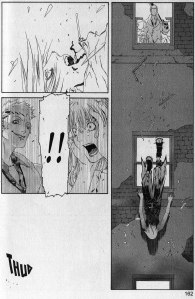 I was largely unmoved by the tale of Naoto, the young girl raised to be a killer by the man she believes murdered her parents. It’s in that segment that Miwa comes closest to flat, straight-faced noir, and while it’s executed well, it lacks the dollops of quirky, what-the-hell humor that characterize the rest of the book.
I was largely unmoved by the tale of Naoto, the young girl raised to be a killer by the man she believes murdered her parents. It’s in that segment that Miwa comes closest to flat, straight-faced noir, and while it’s executed well, it lacks the dollops of quirky, what-the-hell humor that characterize the rest of the book. The Comics Reporter notes that
The Comics Reporter notes that
Sunday, Sunday, SUNDAAAAAAAAAAY!
July 24, 2009I’m taking a week off from the license requests. Sometimes you just have to try and catch up with what’s actually available, and Viz isn’t making it easy with all of the freebies on its SIGIKKI and Shonen Sunday sites. It’s the end of the week, and I’m kind of fried, so I’ll take a look at the presumably more lighthearted shônen fare of the latter.
First of all, I have to say that I like the way Viz is assembling these animated trailers. They look nice; Kate Dacey used the one for Daisuke Igarashi’s Children of the Sea in a recent post, and it’s very effective. Second, I don’t really have anything to add to what I’ve already said about Rumiko Takahashi’s Rin-Ne; it’s solid entertainment, but it has yet to change my life. Third, I still don’t like reading comics on a computer, but Viz’s platform is simple enough to use and readable in scale and resolution, at least on my screen.
Now, on to the new series:
In this one, a young man must pretend to be a young woman to fulfill his clan’s obligation to provide princess-protectors to his nation. The ruse goes badly wrong in some unexpected ways, and, judging by the series description, further drastic twists are pending. There’s not much else I can say about it at the moment, other than it’s wonderfully drawn, like all Watase series, and that I already like it loads better than her last licensed outing, Absolute Boyfriend (Viz). That’s good enough for a start.